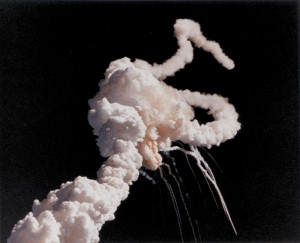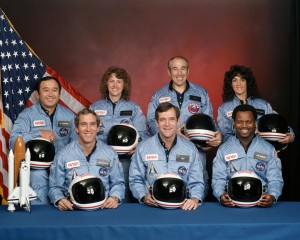The photo is familiar to almost anyone who is familiar with the history of the Space Shuttle program: a corkscrew-shaped cloud of smoke and vapor, nine miles above an unusually-cold Florida coast. The breakup of the Space Shuttle Challenger, STS-51L, was NASA’s largest failure to that point, resulting in the deaths of seven crew members: Commander Dick Scobee, Michael Smith, Dr. Ronald McNair, Lt. Col. Ellison Onizuka, Dr. Judith Resnik, Capt. Gregory Jarvis, and Christa McAuliffe.
 Challenger‘s destruction also delayed the Space Shuttle program for nearly three years while an investigation was conducted; an investigation which revealed a shocking truth – that the accident had been caused by a problem NASA had been warned about nearly ten years prior, but did not address.
Challenger‘s destruction also delayed the Space Shuttle program for nearly three years while an investigation was conducted; an investigation which revealed a shocking truth – that the accident had been caused by a problem NASA had been warned about nearly ten years prior, but did not address.
The Rogers Commission, which was tasked with investigating the accident and staffed by such well-known names as Neil Armstrong*, Richard Feynman**, Sally Ride†, and Chuck Yeager††, found that the willful ignorance of the problem, decision to launch, and eventual breakup of Challenger were all symptoms of a deeper organizational problem at NASA. A problem which cursed them for years. And a problem which you face even today.
Invisible Sin
A space shuttle is the most complicated vehicle humans ever built, but Challenger was brought down by a remarkably simple thing. The breakup was caused by a failed O-ring, the same kind of problem that causes a leaky kitchen faucet; only in this case, it caused the 6,000° rocket gases to burn through the sides of the booster, pushing it into the massive orange fuel tank and setting off all of the remaining rocket fuel at once.
The word “breakup” might be a little deceptive here. “Fireball” might be better.
A 1977 investigation showed that the O-ring was not up to its task, and the second-ever flight of the space shuttle in 1981 proved that the O-ring was eroding during launch. But despite being warned, NASA never attended to the issue. Even the day before launch, when NASA was told that the weather was going to be far colder than the O-ring had ever been tested, they ignored warnings and insisted on continuing with the mission. Those involved with the discussion suffered from “Go fever” – a tendency to ignore major problems and rush to get things done, regardless of the consequences.
NASA was not blind to their problems. They were willfully ignorant of it. The Rogers Commission called it “an accident rooted in history.” An accident that didn’t just affect those who caused it.
Sin Exposed
As with most of us, NASA’s errors didn’t just affect those making the decisions. The people who decided to launch the shuttle that morning weren’t the ones who died. It was the people who were aboard the craft – innocent astronauts, even civilians, who were not told of the risks or informed that climbing aboard the rocket could be the last thing they ever did.
 And the reason I mention that this happens to most of us is because – as someone told me years ago – sin splatters. No matter how minor you think your sins are, what you commit don’t just affect you. It harms your family, destroys your treasured relationships, and injures innocent people you love in ways you could never have expected. Your gluttony causes someone who looks up to you to struggle with food. Your lust tears your family apart. Your sharp tongue deepens a friend’s depression. Your anger causes fear in your coworkers. Your apathy causes those around you to lose trust in you.
And the reason I mention that this happens to most of us is because – as someone told me years ago – sin splatters. No matter how minor you think your sins are, what you commit don’t just affect you. It harms your family, destroys your treasured relationships, and injures innocent people you love in ways you could never have expected. Your gluttony causes someone who looks up to you to struggle with food. Your lust tears your family apart. Your sharp tongue deepens a friend’s depression. Your anger causes fear in your coworkers. Your apathy causes those around you to lose trust in you.
Sure, you’re unlikely to cause a major catastrophe resulting in the deaths of seven people on live television, but the wounds you can leave are very deep indeed, even if it’s just a trace of bitterness in the heart of your spouse.
Of course, the result of NASA’s sin was no minor setback. The seven people who died aboard the shuttle were innocent victims of NASA’s failure. Their deaths revealed NASA’s “Go fever” and prompted sweeping changes in their procedures and planning.
Repentance
After NASA’s sin was laid bare, President Reagan ordered NASA to implement the Rogers Commission’s recommendations, and widespread policy changes were made. The boosters were redesigned from the ground up, and changes in communication chains were put in place. It seemed as though NASA had been fixed.
But 17 years later – almost to the day – something happened that showed NASA still had a bit of that “Go fever.” On February 1, 2003, Space Shuttle Columbia experienced a catastrophic disintegration during its return to Earth. Investigation of the accident revealed that a falling piece of foam had damaged the heat shield on the shuttle’s left wing, meaning that the intense temperatures spacecraft go through on re-entry melted Columbia‘s wing with no resistance. This was a potential problem that NASA was aware of, but which they had deemed an acceptable risk. That decision caused the deaths of seven more crew members.
Repentance isn’t fun, and it isn’t easy. More than apologizing, you have to admit you were wrong and change your entire course of action. Repentance requires us to stop going the wrong way, turn around, and start going another way. It’s painful, it’s difficult, and it’s absolutely crucial.
Lack of repentance is deadly. When our sin is revealed, ignoring the warnings is a risk we can’t take. It can cause our souls to deaden to the leading of the Holy Spirit. But the risk is not just to us and our souls; it’s to the innocent people around us, as well.
The legacy of Challenger and her crew lives on in the names of schools, science centers, and other memorials around the United States. But we also need to learn the lessons that NASA failed to; when we don’t repent, our sin can splatter out again, hurting those we love the most.
And we need to keep reaching onward; pursuing the stars, pursuing new challenges, and pursuing the God who can give them both to us.
Godspeed, Challenger crew.
• • •
Thank you for reading Redeeming Culture.
• Neil Armstrong: Accomplished pilot, Spaceflight pioneer, First man on the moon
• Richard Feynman: Theoretical physicist, Nobel Prize winner
• Sally Ride: Physicist, Youngest American Astronaut, First American Woman in space
• Chuck Yeager: War hero, Record-setting test pilot, First pilot to fly faster than the speed of sound
